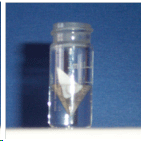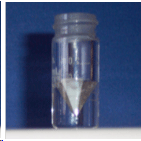 |
 |
| Spin vane improperly placed in conical vial (upside-down). | Spin vane properly placed in conical vial (point down). |
Last updated
1. General
If you don't have the chance to finish all the parts of the experiment this week, you will have to do so next week i.e., TLC or UV-Vis spectroscopy.
Review the following topics: recrystallization theory, vacuum filtration, chromatography, Beer-Lambert Law
Note for the teaching assistant: Dibenzyl ketone has a melting point close to room temperature. Place the bottle in warm water (not boiling water!) at the beginning of the lab section. Do not forget to remove it at the end.
2. Experiment
The student has to use his/her own benzil first before using the supply from lab support. If you did not finish the PTC experiment, you will have to finish this experiment first before you can perform the Aldol reaction. You have to use your own benzil in the Aldol reaction.
In the initial stage of the experiment, absolute ethanol is used as solvent. The glassware has to be dry as well.
Both ketones have to be dissolved by bringing the solution to a gently boil before adding the ethanolic potassium hydroxide solution drop wise. The color should change from yellow to dark purple immediately. A very dark precipitate usually forms after a few minutes into the reaction. If this does not occur after five minutes, a little bit more of ethanolic potassium hydroxide solution can be added. The mixture is then refluxed for an additional ten minutes. If the color remains tan in color, the mixture is discard the mixture after cooling. The reaction has be started over making sure that all chemicals used are correct i.e., absolute ethanol as solvent and that the glassware is dry!
WARNING: The entire KOH solution should not be added at the same time. This will most likely cause a pretty violent reaction and the suspension will spill out of the condenser resulting in a purple mess! The spin vane has to be correctly placed in the conical vial (=point down). This will keep the solid in suspension and usually reduces bumping as well.
 |
 |
| Spin vane improperly placed in conical vial (upside-down). | Spin vane properly placed in conical vial (point down). |
For the recrystallization step, a minimum amount of solvent should be used. Excessive boiling is not advisable either in this case, because a solvent mixture is used here. The solvent would change in its composition and therefore the solubility behavior of the compound at high and low temperatures, which poses a huge problem in the recovery of the pure product..
The filtrate from the recystallization is collected in a separate container provided by the lab support.
The solution for the TLC should be fairly diluted (5 mg/mL ethyl acetate). The TA is going to provide solutions for the two reagents. A capillary spotter should be used to apply the sample to the TLC plate (your TA will show you how you can make it). Once the TLC plate is in the jar, the jar is closed and allowed to sit undisturbed on the bench to develop the TLC.
The solution for the UV-Vis part has to be fairly diluted (very light pink). Try to estimate the molar extinction coefficients based on the concentration and the absorbance values using Beer's Law. The e-values are given in the UV-Vis chapter of the reader.
It is important that the entire sample is dissolved before the stock solution is diluted to the "proper" concentration.
3. Things to think about
a. Why do both ketones have to be dissolved before the ethanolic KOH solution is added?
b. How can the differences in Rf values for the the three compounds be rationalized in the TLC experiment? (Hint: Computer lab meeting 4)
c. Why is a solvent mixture used to purify the crude product instead of the single solvent in the mixture?
d. What does the experimenter observe in the UV-Vis spectrum of the final product?
e. How would the 13C-NMR spectrum change if you lower the temperature of the solution?